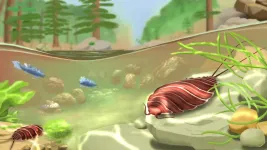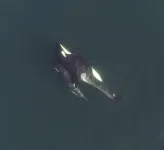(Press-News.org) The old cousins of the common woodlice were crawling on Irish land as long as 360 million years ago, according to new analysis of a fossil found in Kilkenny.
The research, published today (00.01 Wednesday 16 June) in the science journal Biology Letters, used state-of-the-art modern imaging technology to create a new picture of the Oxyuropoda - a land-based creature larger than the modern woodlice - using a fossil found in Kiltorcan, Co Kilkenny in 1908.
Lead researcher Dr Ninon Robin, a postdoctoral researcher at University College Cork's (UCC) School of Biological, Earth and Environmental Sciences said that their work advances science's understanding of when land-dwelling species of crustaceans roamed the earth, and what they looked like.
Dr Robin said:
"Woodlice, and their relatives form a group of crustaceans named peracarids that are as species-rich as the more famous group comprising krill, crabs and shrimps named eucarids. From their ancestral marine habitat some peracarids have, unlike eucarids, evolved fully terrestrial ground-crawling ecologies, inhabiting even commonly our gardens, for example pillbugs and sowbugs, which are very common in Ireland.
"Using new modern imaging techniques, we determined that Oxyuropoda was actually a peracarid crustacean, even the oldest known one; which supports the theory that woodlice cousins were already crawling on Irish lands at that very early time, 360 million years ago.
"From previous genomic and molecular studies, scientists had suggested that this group ofcrustaceans must have appeared around 450 million years ago. However their fossils were very rare in the Paleozoic era, which was 560-250 million years ago, so we had no idea at all how they looked at that time, nor if they were marine or yet terrestrial.
"Our work is an advance in the field of the evolution of invertebrate animals, especially crustaceans, and in our knowledge of the timing of their colonisation of land," she said.
The fossil that formed the basis of this research was found in 1908 in a quarry at Kiltorcan, Co Kilkenny. The site has been internationally known since the mid 19th-century as the location of a number of plant, freshwater bivalve, fish, and crustacean fossils.
INFORMATION:
The international team behind this research includes Dr David Jarvis, also of UCC, and scientists from University of Lausanne in Switzerland, Harvard University in the US, and Naturalis Biodiversity Center of Leiden the Netherlands.
Québec produces more strawberries than any other Canadian province. Strawberries are delicate and difficult to keep fresh. In response to this challenge, Monique Lacroix, a professor at at the Institut national de la recherche scientifique (INRS), and her team have developed a packaging film that can keep strawberries fresh for up to 12 days. The team's findings on how this film protects against mould and certain pathogenic bacteria have been published in Food Hydrocolloids.
The innovative film is made of chitosan, a natural molecule found in shellfish shells. This food industry by-product contains key antifungal properties ...
Thirty state-of-the-art IPCC-climate models predict dramatically different climates for the Northern Hemisphere, especially Europe. An analysis of the range of responses now reveals that the differences are mostly down to the individual model's simulations of changes to the North Atlantic ocean currents and not only - as normally assumed - atmospheric changes. The work, by Katinka Bellomo, National Research Council of Italy, Institute of Atmospheric Sciences and Climate, and colleagues is published today in Nature Communications and is part of the European ...
A study led by Fernando Colchero, University of Southern Denmark and Susan Alberts, Duke University, North Carolina, that included researchers from 42 institutions across 14 countries, provides new insights into the aging theory "the invariant rate of ageing hypothesis", which states that every species has a relatively fixed rate of aging.
- Human death is inevitable. No matter how many vitamins we take, how healthy our environment is or how much we exercise, we will eventually age and die, said Fernando Colchero.
He is an expert in applying statistics and mathematics to population biology and an associate professor at Department of Mathematics and Computer Science, University of Southern Denmark.
"We were able to shed light on the invariant rate of ageing hypothesis by combining ...
Teachers play a key role in supporting children's development in early childhood education classrooms such as Head Start. Research shows significant associations between teachers' depressive symptoms and their students' social and emotional development. However, little research has focused on the associations between teachers' depressive symptoms and academic outcomes of preschoolers from low-income families. Specifically, one important pathway that has not been examined is whether teacher depressive symptoms have implications for the quality of family-teacher relationships. This in turn could affect how supportive parents ...
An herbicide widely used in agriculture, forestry and other applications can cause deleterious effects on the reproductive health of a common perennial plant found in forests in British Columbia, Canada. Researchers reported in the journal END ...
Despite rapid development of electric vehicles (EVs), the safety of the lithium-ion (Li-ion) batteries remains a concern as they are as a fire and explosion risk. Among the various approaches to tackle this issue, Korean researchers have used semiconductor technology to improve the safety of Li-ion batteries. A research team from the Korea Institute of Science and Technology (KIST) led by Dr. Joong Kee Lee of the Center for Energy Storage Research has succeeded in inhibiting the growth of dendrites, crystals with multiple branches that cause EV battery fires by forming protective semiconducting passivation layers on the surface of Li electrodes.
When ...
Chestnut Hill, Mass. (6/16/2021) - In unconventional superconductors, electrons often exhibit a tendency towards spatial ordering within their atomic structure.
In high-temperature superconductors, this comes in the form of the electronic structure exhibiting a pronounced difference in the lattice-bound directions along which atoms are ordered.
Within these materials, this electronic activity in turn breaks the rotational symmetry of the crystal, a phase known as electronic nematicity. Researchers have sought to better understand this novel electronic state, which co-exists with superconductivity.
Boston College Associate Professor of Physics Ilija Zeljkovic and an international team of researchers set out to better understand the atomic-scale signature ...
The omega-3 polyunsaturated fatty acids (PUFAs) eicosapentaenoic acid (EPA) and docosahexaenoic acid (DHA) are found in oily fish. Researchers from the National Institute of Health Research (NIHR) Maudsley Biomedical Research Centre assessed the effects of high doses of EPA and DHA in lab-grown neurones and then in patients to help clarify how they reduce inflammation and depression. This novel approach allowed the scientists to identify an important molecular mechanism which can help inform the development of potential new treatments involving omega-3 fatty acids for patients with depression.
Lead author Dr Alessandra Borsini, NIHR Maudsley BRC Senior Postdoctoral ...
Killer whales have complex social structures including close "friendships", according to a new study that used drones to film the animals.
The findings show that killer whales spend more time interacting with certain individuals in their pod, and tend to favour those of the same sex and similar age.
The study, led by the University of Exeter and the Center for Whale Research (CWR), also found that the whales become less socially connected as they get older.
"Until now, research on killer whale social networks has relied on seeing the whales when they surface, and recording which whales are together," said lead author Dr Michael Weiss, of the University of Exeter.
"However, because resident killer whales stay in the social groups into which they're born, how closely related whales ...
The period preceding the emergence of behaviourally modern humans was characterised by dramatic climatic and environmental variability - it is these pressures, occurring over hundreds of thousands of years that shaped human evolution.
New research published today in the Cambridge Archaeological Journal proposes a new theory of human cognitive evolution entitled 'Complementary Cognition' which suggests that in adapting to dramatic environmental and climactic variabilities our ancestors evolved to specialise in different, but complementary, ways of thinking. ...




